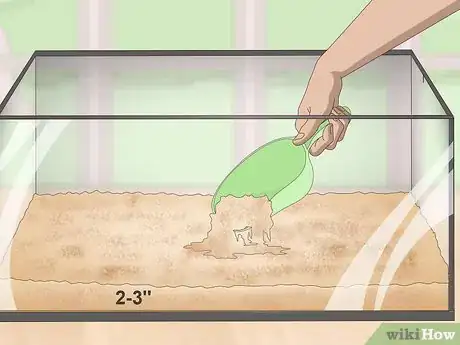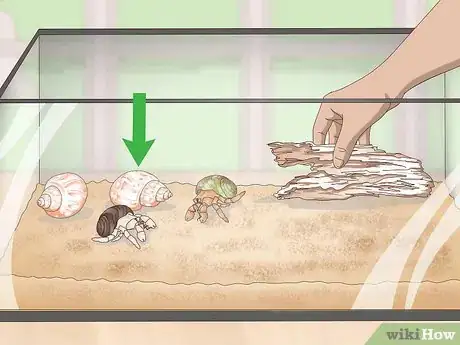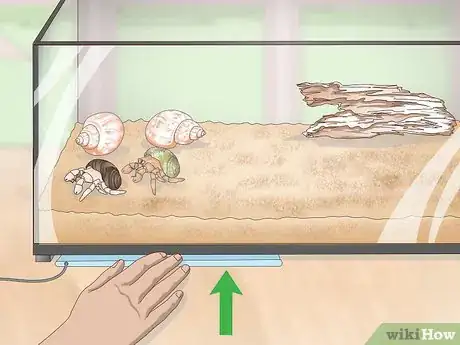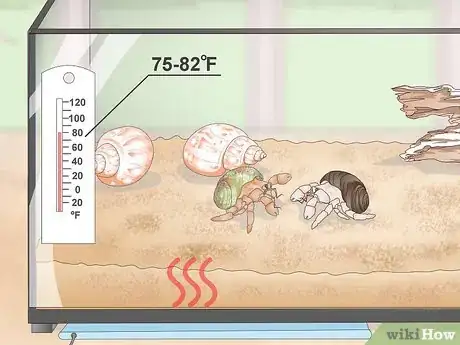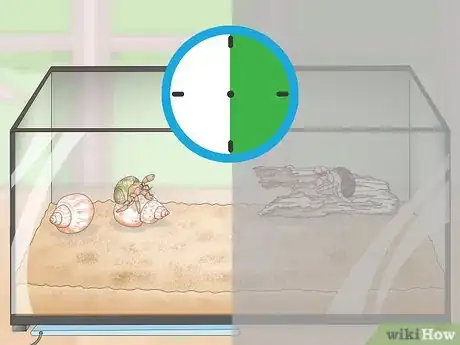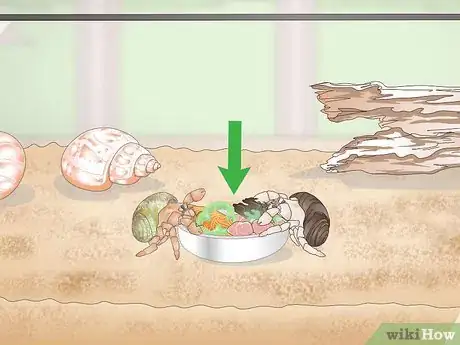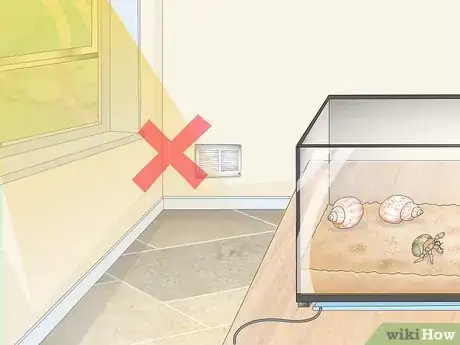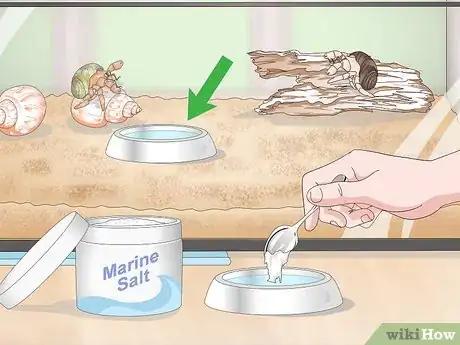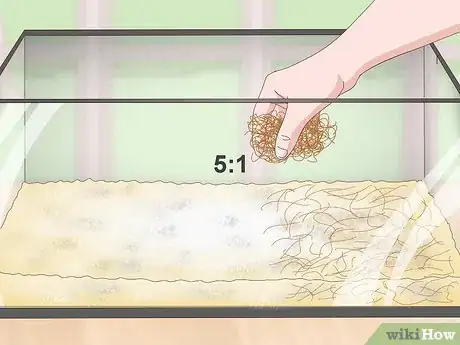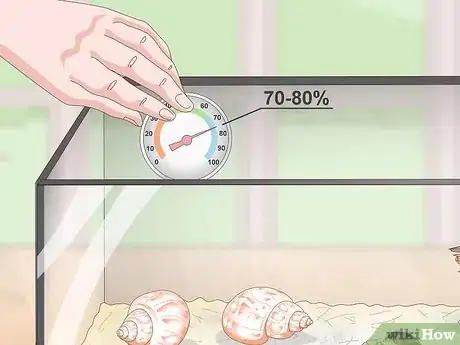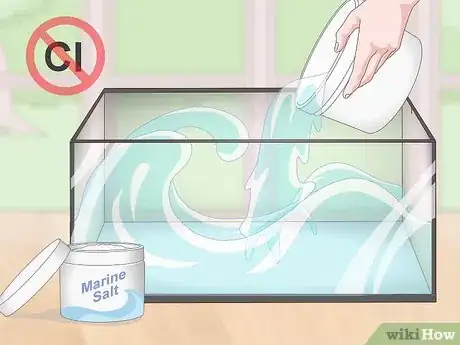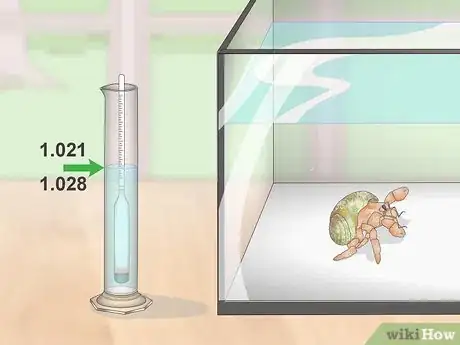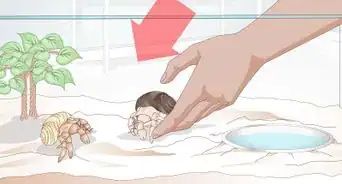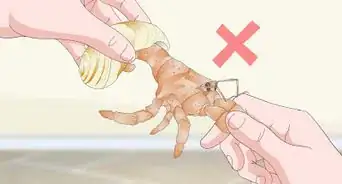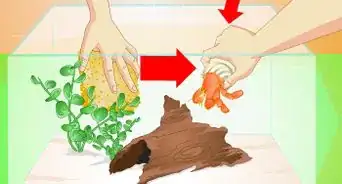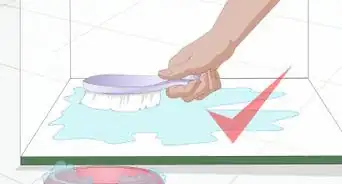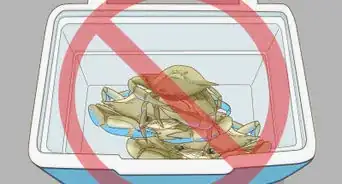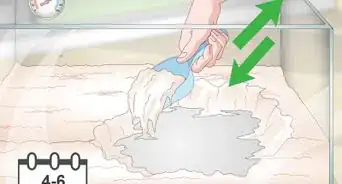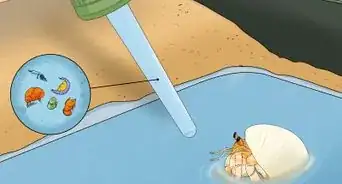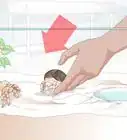This article was co-authored by Marshall Stephens. Marshall Stephens is an Aquarium Expert at Private Oceans Aquariums in West Palm Beach, Florida. Marshall has over 20 years of experience in the aquarium industry and focuses on captive-bred animals. They specialize in tropical and marine aquariums and are a contributor to the Loggerhead Marine life center in Jupiter Florida.
There are 8 references cited in this article, which can be found at the bottom of the page.
This article has been viewed 160,637 times.
Hermit crabs are unique crustaceans that can live very long lives in the right habitat. If you're thinking of buying some—whether they're land crabs or saltwater crabs—you need to provide them with a well-maintained tank and the right food and water. Once you start developing a habitat, adjust it based on whether your crabs are a land or saltwater species. After this, they're very easy to care for!
Things You Should Know
- Fill up half of your hermit crab's tank with play sand mixed with Eco Earth substrate. Your hermit crab needs lots of sand to dig and tunnel in.
- Include at least 3-5 large empty hermit crab shells for every 1 crab you have.
- Add fake branches, hollow logs, and vines for your hermit crab to climb on.
- Place an under-tank heater under one-half of the tank. Your hermit crab needs a warm and cool side of their tank.
Steps
Developing a Hermit Crab Habitat
-
1Choose a tank with 10–20 gallons (38–76 L) of space per 2 crabs. This is the minimum amount of space you should give your crabs. Always make sure that your tank has a lid to prevent your crabs from escaping and to ensure that it adequately holds humidity. For the best results, use a mesh lid covered with Plexiglas or a screen lid with locks. You can also cover a mesh lid with plastic wrap or weather stripping. Hermit crabs do not need air. Instead they breathe through gills. If your humidity is less than 75% you will slowly and painfully suffocate them. [1]
- Never use plastic tanks, as they don't hold heat or humidity well.
- Jumbo hermit crabs require about 5 gallons (19 L) of space per 1 crab.
-
2Place 6 to 10 inches (15 to 25 cm) of play sand mixed with EcoEarth onto the bottom. The rule of thumb is at least half the height of your tank in order to provide them the correct depth to burrow and dig tunnels. Proper substrate depth will help with fighting or stress with your crabs and also help maintain a proper humidity in your tank. Your crabs need to burrow during molting, which is the process that allows them to grow. Purchase play sand from a home repair store. The "hermit crab" sand from pet stores often has harsh chemicals and the play sand is cheaper at the home improvement store. You'll want to mix the playsand and Ecoearth to a consistency that is similar to a sand castle.[2]
- For land crabs, leaf litter and bark make a nice addition to your substrate but are not necessary so long as your tank has a base of sand and eco earth.
Advertisement -
3Provide your crabs with hiding places and objects to climb on. Give your tank at least 3-5 large empty hermit crab shells for every 1 crab. These shells provide shelter and housing for the crabs as they grow and can be purchased from pet stores. You can also add a natural and untreated hollow log for both climbing and shelter.[3]
- Swap out the initial shells for bigger ones as the crabs grow larger.
- Never use painted shells—they are dangerous and can be toxic to your crabs.
- Purchase branches and vines at pet supply stores or dollar stores for the crabs to climb on.
- Avoid any conifers and do not ever use metal inside the tank.
-
4Install an under tank heater (UTH) on one side of your tank, NEVER under the substrate. Hermit crabs need a range of temperatures since they are cold-blooded. They rely on being able to move across their environment to adjust their body temperature. Place a UTH under one side of your heater (it doesn't matter which one) to create a warmer end and provide such a range. Afterward, add thermometers—one for the cool end and one for the warmer end.[4]
- Purchase UTHs from pet stores or online suppliers.
-
5Keep the tank temperature between 75 to 82 °F (24 to 28 °C) during the day. Set the tank temperature with a temperature controller and monitor it regularly. If you can't read the temperature directly, use an LCD thermometer. A small dip in temperature at night is normal so long as it doesn't go below 72 °F (22 °C). Remember that extended periods of cool temperatures can make your crabs sick and even die.[5]
- Keep an eye on the temperature daily. The temperature at the cooler end of the tank should be about 70–72 °F (21–22 °C), and up to 82 °F (27.8 °C) at the warm end.
- Although nighttime temperature dips are normal, tank temperature should never remain at 72 °F (22 °C) for long periods of time.
-
6Expose your hermit crabs to a normal 12-hour cycle of light and dark. Place your tank in a location that exposes crabs to a standard light cycle. You can also install overhead lights if your tank doesn't get enough light. Always ensure the bulbs aren't covered by a plastic barrier or glass and replace them every 12 months. Just remember that crabs need a 12-hour cycle of dark and light for proper molting.[6]
- Don't set the tank in direct sunlight. A glass tank will amplify the heat of the sun and can overheat very quickly, which can cause heat damage and illness to your crabs.
- If your crabs get sufficient daytime light, you can skip the tank lights.
- Install UVB bulbs to provide both light and heat for your crabs. This is a great option if you're having trouble getting the tank temperature hot enough. If you need to heat your crabs at night, use bulbs that don't release UV rays.
-
7Feed your hermit crabs dark vegetables, meats, chopped fruit, and seeds. Hermit crabs are scavengers and require a very diverse diet—they cannot live on commercial foods alone. Offer daily servings of seaweeds and algae, proteins in the form of meats, calcium-rich foods, organic earthworm castings, chitin sources such as mealworms and shrimp, and fresh fruits and vegetables. Your crabs also need cellulose, which is found in cork bark, grape wood, and cholla wood.[7]
- Give your crabs chopped coconuts, papayas, mangoes, and any fruits that are common in their native habitat.
- For meat and seafood, you can serve them raw or cooked and with or without bones. Just make sure there is no butter, salt, or sauce on them.
- Always place meat into the habitat at night and remove it in the morning to prevent flies or scavengers.
-
8Put your hermit crab habitat in a safe and stable environment. Always keep your tank in a room that remains at an acceptable and steady temperature. This means away from vents that release cold air and away from windows and outdoor locations that expose them to direct sunlight.
- Keep your habitat away from pets and areas where you use cologne, hairspray, and room deodorants.
Adjusting the Habitat for Land Hermit Crabs
-
1Place a fresh water dish and a marine salt water dish in the bowl. Provide your crabs with a dish of marine salt water and another with fresh water. Be sure they have access to both at all times. To create salt water, buy marine grade salt and mix 1 ounce (28 g) per 4 cups (950 mL) of water.[8]
- Both water dishes should be free from ammonia, chloramines, and chlorine. Chlorine will blister your crab's gills. Always use a water conditioner that removes chloramines and heavy metals, as many homes have copper pipes and hermit crabs are especially sensitive to copper.
- Make sure the water dishes are at least as deep as your largest crab. It is not true that they will drown. Tupperware bowls or small paint trays work well.
- Give your smaller crabs a way to climb out of the bowl, such as small glass pebbles or uncoated river pebbles.
-
2Create a substrate of 5 parts growing medium and 1 part eco earth. Aragonite sand is the best choice for a growing medium, followed by coco fiber. Both of these materials can be found in reef stores. Coco fiber should be expanded with bottled water or dechlorinated water. Never use anything with cedar or any other conifer.[9]
- Crushed coral is also a suitable substrate, although it's typically a more expensive option.
- Make sure the eco earth is dry when you mix it into your sand to prevent the substrate from waterlogging.
-
3Keep the humidity between 70 and 80 percent at all times. Install a hygrometer in the tank and monitor humidity daily. A moist substrate will help you keep humidity up. To keep it moist, poke a hole in each corner of the substrate and pour 1⁄4 cup (59 mL) of water into them every 3 to 4 weeks.[10]
- Pour {{convert|1/2|cup|mL|adj=on|| of tank moss across the substrate to increase moisture. You can also place the cup into the tank to give your crabs a moss pit to hide in. Never use peat moss.
- Don't use sponges—they harbor bacteria and can make you and your hermit crabs sick.
Tailoring the Habitat to Saltwater Hermit Crabs
-
1Fill your tank with chlorine-free saltwater. Make sure you add ½ cup (118 grams) of sea salt for every 1 gallon (3.8 L) of water. Mix the sea salt in thoroughly and wait until it dissolves and the water is clear. Wait 2 to 3 hours until the water is at room temperature before adding it to the aquarium.[11]
- Purchase pre-mixed saltwater from pet stores.
-
2Keep the water pH between 8.0 and 8.4. Use pH paper to test the pH of your water daily. To increase pH, add 1 teaspoon (4.9 mL) of baking soda for every 5 gallons (19 L) of water. To decrease pH, add peat moss.[12]
- Buy pH paper and peat moss from pet stores.
-
3Test your water for nitrite and ammonia regularly. Dip ammonia into the water regularly to make sure levels are undetectable. Similarly, use nitrate strips to make sure levels are less than 10 ppm.[13]
- Purchase both ammonia and nitrite testing papers from pet stores, big-box suppliers, or online stores.
-
4Keep the specific gravity between 1.021 and 1.028. Pour a sample of the habitat water into a container and insert a hydrometer. Once it stops floating, check the waterline and read the corresponding specific gravity. When specific gravity levels are too high, replace saltwater with freshwater 10 percent at a time to lower it. If specific gravity levels are too low, raise it by replacing up to 10 percent of the freshwater with saltwater at a time.[14]
- Hydrometer scales read "specific gravity," which is the ratio of the liquid's density to the water's density.
- Make sure replacement water is the same temperature as aquarium water.
- Don't alter specific gravity more than 0.001 per day. Anything more can cause shock to your hermit crabs. If necessary, adjust salinity over the course of 3 to 4 days.
Community Q&A
-
QuestionHow do I stop hermit crabs from fighting?
 Community AnswerYou don't need to, as hermit crabs are very social and calm with any gender or age of crab. If fighting persists, it may be because the crabs are different breeds or because it's mating season. Try separating them or providing them with a female each.
Community AnswerYou don't need to, as hermit crabs are very social and calm with any gender or age of crab. If fighting persists, it may be because the crabs are different breeds or because it's mating season. Try separating them or providing them with a female each. -
QuestionDo I use salt water or fresh water to keep substrate moist?
 CaeiiaTop AnswererFreshwater.
CaeiiaTop AnswererFreshwater. -
QuestionWhere is the best place to put the cage?
 Community AnswerSomewhere with some light, but not direct sunlight, as hermit crabs are nocturnal and like to sleep in the daytime. Also put the cage somewhere where you will definitely remember to feed it, like the kitchen or living room.
Community AnswerSomewhere with some light, but not direct sunlight, as hermit crabs are nocturnal and like to sleep in the daytime. Also put the cage somewhere where you will definitely remember to feed it, like the kitchen or living room.
Warnings
- New hermit crabs need time to adjust to their new home and should not be held or disturbed for 2 to 3 weeks after you settle them in.⧼thumbs_response⧽
- Never dig up a buried hermit crab. A buried crab may be trying to molt, and disturbing it can mean its death. Remember that hermit crabs are very susceptible to stress.⧼thumbs_response⧽
- Do not use tap water. Always use a water conditioner that removes chloramines and heavy metals, or use distilled water. If you use distilled water, you must use marine salt water to replace the electrolytes missing from the distilled water.⧼thumbs_response⧽
- Hermit crabs like to swim in their water dishes to refill their shell water and balance the salinity within it. Always give them water dishes that are at least as deep as they are tall. They will not drown as long as you give them a way to climb out.⧼thumbs_response⧽
- Change their food daily, and don't ever offer raw shellfish—sometimes they carry diseases that can kill your crabs.⧼thumbs_response⧽
Things You'll Need
- Glass tank, aquarium, or terrarium
- 2 water dishes
- Marine salt mix and water conditioner that removes heavy metals and chloramines.
- Humidity and temperature gauges
- Climbing toys and hiding places
- Extra shells (for molting)
- Safe substrate
- Mesh lid and a cover to hold in humidity
- Heat source for cool climates
References
- ↑ https://animals.mom.me/homemade-hermit-crab-habitat-1986.html
- ↑ https://animals.mom.me/homemade-hermit-crab-habitat-1986.html
- ↑ https://animals.mom.me/homemade-hermit-crab-habitat-1986.html
- ↑ http://crabstreetjournal.org/blog/2016/03/23/setting-proper-crabitat/
- ↑ http://crabstreetjournal.org/blog/2016/03/23/setting-proper-crabitat/
- ↑ http://crabstreetjournal.org/blog/2016/03/23/setting-proper-crabitat/
- ↑ https://hermit-crabs.com/food.html
- ↑ http://crabstreetjournal.org/blog/2016/03/23/setting-proper-crabitat/
- ↑ https://animals.mom.me/homemade-hermit-crab-habitat-1986.html
- ↑ https://animals.mom.me/keep-hermit-crab-habitat-humid-1478.html
- ↑ https://animals.mom.me/how-to-make-salt-water-for-hermit-crabs-12505292.html
- ↑ https://animals.mom.me/raise-saltwater-hermit-crabs-1251.html
- ↑ https://animals.mom.me/raise-saltwater-hermit-crabs-1251.html
- ↑ https://animals.mom.me/correct-marine-aquarium-salinity-4012.html
About This Article
To create a hermit crab habitat, buy a glass tank with a minimum of 5 gallons of space for every 2 crabs. Next, line the bottom of the tank with 2 to 3 inches of fine gravel or bark, which you can get at a pet store. Then, add objects like hollow logs and large, empty hermit crab shells so that the crabs have things to climb on. Finally, install an under tank heater on one side of the tank and maintain a temperature between 75 and 82 °F. For tips on adjusting the habitat depending on what kind of hermit crabs you have, read on!

